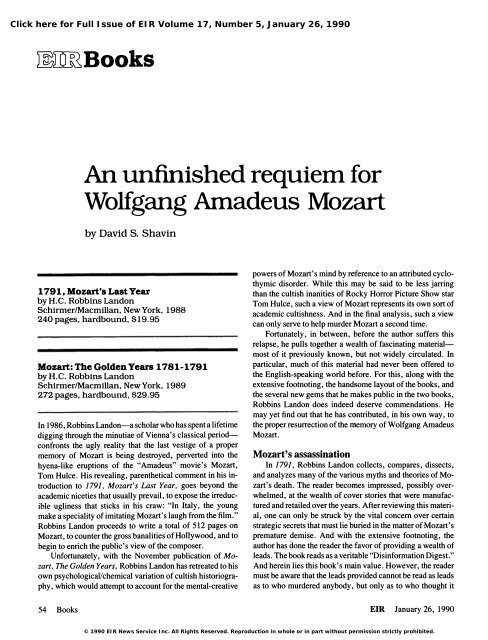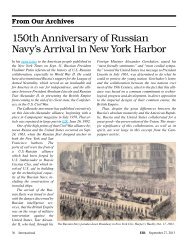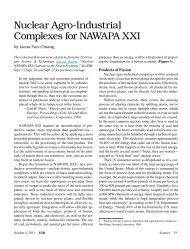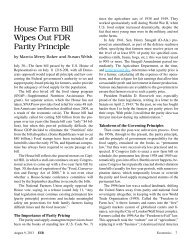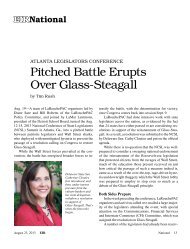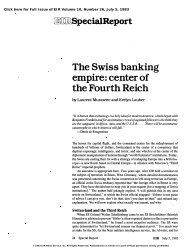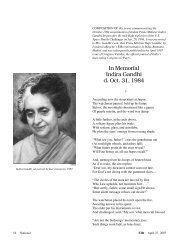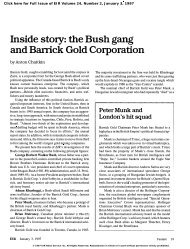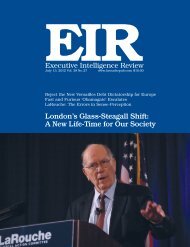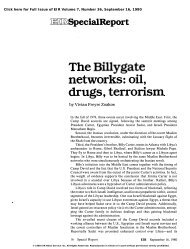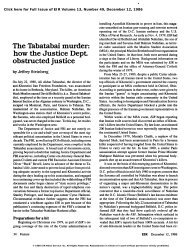An Unfinished Requiem for Wolfgang Amadeus Mozart - Executive ...
An Unfinished Requiem for Wolfgang Amadeus Mozart - Executive ...
An Unfinished Requiem for Wolfgang Amadeus Mozart - Executive ...
You also want an ePaper? Increase the reach of your titles
YUMPU automatically turns print PDFs into web optimized ePapers that Google loves.
Click here <strong>for</strong> Full Issue of EIR Volume 17, Number 5, January 26, 1990<br />
TIrnBooks<br />
<strong>An</strong> unfinished requiem <strong>for</strong><br />
<strong>Wolfgang</strong> <strong>Amadeus</strong> <strong>Mozart</strong><br />
by David S. Shavin<br />
1791, <strong>Mozart</strong>'s Last Year<br />
by H.C. Robbins Landon<br />
SchirmeriMacmillan, New York, 1988<br />
240 pages, hardbound, $19.95<br />
<strong>Mozart</strong>: The Golden Years 1781-1791<br />
by H.C. Robbins Landon<br />
SchirmeriMacmillan, New York, 1989<br />
272 pages, hardbound, $29.95<br />
In 1986, Robbins Landon-a scholar who has spent a lifetime<br />
digging through the minutiae of Vienna's classical period<br />
confronts the ugly reality that the last vestige of a proper<br />
memory of <strong>Mozart</strong> is being destroyed, perverted into the<br />
hyena-like eruptions of the "<strong>Amadeus</strong>" movie's <strong>Mozart</strong>,<br />
Tom Hulce. His revealing, parenthetical comment in his in<br />
troduction to 1791, <strong>Mozart</strong>'s Last Year, goes beyond the<br />
academic niceties that usually prevail, to expose the irreduc<br />
ible ugliness that sticks in his craw: "In Italy, the young<br />
make a speciality of imitating <strong>Mozart</strong>'s laugh from the film."<br />
Robbins Landon proceeds to write a total of 512 pages on<br />
<strong>Mozart</strong>, to counter the gross banalities of Hollywood, and to<br />
begin to enrich the public's view of the composer.<br />
Un<strong>for</strong>tunately, with the November publication of Mo<br />
zart, The Golden Years, Robbins Landon has retreated to his<br />
own psychological/chemical variation of cultish historiogra<br />
phy, which would attempt to account <strong>for</strong> the mental-creative<br />
54 Books<br />
powers of <strong>Mozart</strong>'s mind by reference to an attributed cyclo<br />
thymic disorder. While this may be said to be less jarring<br />
than the cultish inanities of Rocky Horror Picture Show star<br />
Tom Hulce, such a view of <strong>Mozart</strong> represents its own sort of<br />
academic cultishness. <strong>An</strong>d in the final analysis, such a view<br />
can only serve to help murder <strong>Mozart</strong> a second time.<br />
Fortunately, in between, be<strong>for</strong>e the author suffers this<br />
relapse, he pulls together a wealth of fascinating material<br />
most of it previously known, but not widely circulated. In<br />
particular, much of this material had never been offered to<br />
the English-speaking world be<strong>for</strong>e. For this, along with the<br />
extensive footnoting, the handsome layout of the books, and<br />
the several new gems that he makes public in the two books,<br />
Robbins Landon does indeed deserve commendations. He<br />
may yet find out that he has contributed, in his own way, to<br />
the proper resurrection of the memory of <strong>Wolfgang</strong> <strong>Amadeus</strong><br />
<strong>Mozart</strong>.<br />
<strong>Mozart</strong>'s assassination<br />
In 1791, Robbins Landon collects, compares, dissects,<br />
and analyzes many of the various myths and theories of Mo<br />
zart's death. The reader becomes impressed, possibly over<br />
whelmed, at the wealth of cover stories that were manufac<br />
tured and retailed over the years. After reviewing this materi<br />
al, one can only be struck by the vital concern over certain<br />
strategic secrets that must lie buried in the matter of <strong>Mozart</strong>'s<br />
premature demise. <strong>An</strong>d with the extensive footnoting, the<br />
author has done the reader the favor of providing a wealth of<br />
leads. The book reads as a veritable "Disin<strong>for</strong>mation Digest."<br />
<strong>An</strong>d herein lies this book's main value. However, the reader<br />
must be aware that the leads provided cannot be read as leads<br />
as to who murdered anybody, but only as to who thought it<br />
EIR January 26, 1990<br />
© 1990 EIR News Service Inc. All Rights Reserved. Reproduction in whole or in part without permission strictly prohibited.
vital to protect certain state secrets, and to create disin<strong>for</strong><br />
mation.<br />
One example will have to suffice. In the fall of 1823,<br />
thirty-two years after <strong>Mozart</strong>'s death, Salieri is ill, and con<br />
fined in a hospital. Rumors are stoked by the Viennese jour<br />
nalists that Salieri murdered <strong>Mozart</strong>. In October, Beetho<br />
ven 's pupil Ignaz Moscheles manages to get in to see the<br />
isolated Salieri.<br />
The reunion was a sad one. His appearance already<br />
shocked me and he spoke only in broken sentences<br />
about his imminent death. But at the end he said: "Al<br />
though this is my last illness, I can assure you on my<br />
word of honour that there is no truth in that absurd<br />
rumour; you know that I am supposed to have poisoned<br />
<strong>Mozart</strong>. But no, it's malice, pure malice, tell the world,<br />
dear Moscheles, old Salieri, who will soon die, has<br />
told you."<br />
Within weeks, Salieri is reported to have tried, unsuccessful<br />
ly, to commit suicide. The limited access to him is almost<br />
totally closed off. He is isolated until his death, one-and-a<br />
half years later.<br />
Now, Robbins Landon is careful enough not to swallow<br />
the media slanders of Viennese journalism of 1823 in their<br />
attacks on Salieri, though he does not probe into the possible<br />
origins behind this orchestrated campaign. ("Gossip!" was<br />
Beethoven's characterization of this early attempt to tum<br />
<strong>Mozart</strong>'s death into a matter of a personal vendetta. ) Instead,<br />
he seems to accept the Hapsburg family doctrine on the assas<br />
sination, first articulated publicly by Giuseppe Carpani in<br />
1824. This defense is predicated upon the writing of a Haps<br />
burg doctor, the Court Councillor Eduard Vincent Guldener<br />
von Lobes, and is seemingly accepted whole by Robbins<br />
Landon. Having accepted this denial of any poisoning of<br />
<strong>Mozart</strong>, Robbins Landon proceeds to review the medical<br />
speculations regarding <strong>Mozart</strong>'s death.<br />
However, it is the questions unasked, and unexamined,<br />
that mark the shortcomings of his method. If <strong>Mozart</strong> was not<br />
poisoned, then who was running the nasty operation against<br />
Salieri, and why? If the Hapsburgs of 1823 disclaimed the<br />
possibility of the poisoning of <strong>Mozart</strong>, on what grounds<br />
should this be accepted? Would not an answer to the question<br />
of who was feeding Salieri to the wolves, have a bearing on<br />
the question of who knew what was at stake in <strong>Mozart</strong>'s<br />
demise? (<strong>An</strong>d, as we shall come to ask, could the question<br />
of <strong>Mozart</strong>'s assassin possibly be satisfactorily answered<br />
without addressing the question of the suspicious death of<br />
his Emperor, Leopold? ) These lines of inquiry will not be<br />
found in 1791 • <strong>Mozart</strong>'s Last Year.<br />
Interestingly enough, the concluding lines of the above<br />
cited paragraph from Moscheles' diary, Robbins Landon<br />
does not find pertinent, and he chooses to omit them from<br />
his book. Moscheles concludes:<br />
EIR January 26, 1990<br />
With regard to the report hinted at by the dying<br />
man, it certainly had been circulated, without my ever<br />
giving it the slightest belief. Morally speaking he had<br />
no doubt by his intrigues poisoned many an hour of<br />
<strong>Mozart</strong>'s existence.<br />
What Moscheles states here, both explicitly and implicitly,<br />
is certainly, at least, an interesting measure of what Beetho<br />
ven's networks are prepared to believe, and not believe,<br />
regarding <strong>Mozart</strong>'s demise. Salieri may have been used in<br />
the poisoning of <strong>Mozart</strong>'s existence, but one should not look<br />
to him to find out whose poison ended <strong>Mozart</strong>'s life.<br />
Robbins Landon concluded his material on <strong>Mozart</strong> in<br />
1791, by noting: " '<strong>Amadeus</strong>,' play and film, has already<br />
created another [myth], and it may prove difficult to dissuade<br />
the public from the current Shafferian view of the composer<br />
as a divinely gifted drunken lout, pursued by a vengeful<br />
Salieri." In <strong>Mozart</strong>, The Golden Years, Robbins Landon<br />
picks up on this mission. He manages to further undercut<br />
the "<strong>Mozart</strong>-Salieri personality conflict" theory of <strong>Mozart</strong>'s<br />
death by providing the reader a much richer sense of <strong>Mozart</strong>'s<br />
world-with whom he worked, and <strong>for</strong> whom he composed.<br />
The details should be read and appreciated <strong>for</strong> themselves,<br />
but suffice it here to note the following.<br />
The' American' faction<br />
<strong>Mozart</strong> worked with the key republican contact (in Vien<br />
na ) of Benjamin Franklin's "American" network in Europe,<br />
Baron van Swieten. As the author understates the case,<br />
"Swieten was very much en rapport with the re<strong>for</strong>ming ideas<br />
and ideals of Emperor Joseph II." Swieten brought from<br />
Frederick's court in Prussia the knowledge and manuscripts<br />
of Bach and Handel to his post as Prefect of the Imperial<br />
Royal Library in Vienna, where <strong>Mozart</strong> arrived in 1781.<br />
<strong>Mozart</strong> wrote to his father, "Every Sunday at 12 noon I go<br />
to Baron von Suiten [sic]-and there nothing but Handel and<br />
Bach is played. . . . lam making a collection of Bach fugues.<br />
. . . Also Handel's, and these I don't have." In short, <strong>Mozart</strong>,<br />
the <strong>for</strong>mer child prodigy, at the age of 26, was immersed in<br />
Bach's fugues, making powerful discoveries in his quest to<br />
understand, and to master, his own genius.<br />
Robbins Landon introduces the reader to a fascinating<br />
circle of individuals in Vienna's political and cultural life.<br />
Baron van Swieten's circles included the ministers, educa<br />
tors, artists, and officials involved in Joseph's nation-build<br />
ing, in particular, in his education re<strong>for</strong>ms. For example,<br />
<strong>Mozart</strong> per<strong>for</strong>med his quartets with Haydn at the home of the<br />
Hofrat von Greiper, the Court War Secretary in the Bohemi<br />
an-Austrian C 9.«hancellery, and a member of the Imperial<br />
Royal Study SOCiety, which organized the school system. He<br />
was a leading Freemason, who initiated a tax on alcohol, and<br />
helped lead the abolition of statute-labor in Bohemia.<br />
<strong>Mozart</strong>'s lodge was part of the New Crowned Hope<br />
lodge-not an uninteresting name, considering that the Aus-<br />
Books 55
trian Masons were reorganized by Emperor Joseph in the<br />
mid-1780s to weed out the agents. Included among <strong>Mozart</strong>'s<br />
Masonic brothers, along with his father Leopold and his<br />
composer friend Joseph Haydn, were two of Beethoven's<br />
later patrons, Prince Lichnowsky and Prince Nicolaus Ester<br />
hazy, and the Imperial Royal Chamberlain, Johann the<br />
Count.<br />
However, the key event that Robbins Landon-not to<br />
mention all the other, less-helpful <strong>Mozart</strong> scholars-remains<br />
strangely silent about, is the event that shook the courts of<br />
Europe, the American Revolution. Or, to put it differently,<br />
the Western civilization revolution. Simply put, the success<br />
of the American Revolution against King George III, brought<br />
a key question to the <strong>for</strong>e: Were men the loyal subjects of<br />
royalty, of authority based upon blood lines, or were men<br />
made in the image of God, free to hearken to their moral<br />
obligation to develop their God-like capacities?<br />
How our purported scholars today expect to properly treat<br />
the critical questions of culture and creativity in the Europe<br />
of the 1780s (that is, of <strong>Mozart</strong>'s world ), and to ignore this<br />
living, breathing reality of the birth of the American repub<br />
lic-this is truly mind-boggling. Such a bankrupt methodolo<br />
gy could never hope to comprehend why the Founding Fa<br />
thers, why Lafayette, and why indeed <strong>Mozart</strong> would put their<br />
lives on the line, any more than it could comprehend why<br />
today a Chinese student would stand up to the tanks of dic<br />
tators.<br />
<strong>An</strong> extraordinary decade<br />
For example, Robbins Landon motivates his second<br />
book, <strong>Mozart</strong>, The Golden Years, 1781-1791, with a power<br />
ful observation: "I thought, then, that such matters would<br />
interest the public at large, curious to know some of the<br />
background, and indeed <strong>for</strong>eground, of this extraordinary<br />
decade-which brought <strong>for</strong>th a new masterpiece by Haydn<br />
or <strong>Mozart</strong> twice a month on average [emphasis added]." A<br />
stunning observation, properly situated by the author. How<br />
are we to understand such an outburst of creativity? Howev<br />
er, nowhere in 272 well-documented pages is Benjamin<br />
Franklin mentioned. General Lafayette's name is included<br />
on a list of 65 names in January 1792, a list that Austrian<br />
intelligence agencies considered anti-Hapsburg conspirators.<br />
(This same list also includes the names of Schloissnigg and<br />
van Swieten.) No other comment appears. In Robbins Lan<br />
don's account of this extraordinary decade, there is no echo<br />
of the shot heard 'round the world.<br />
Even the key visit made by <strong>Mozart</strong> to Lafayette's family<br />
near Paris (made in 1778, when Lafayette is in the United<br />
States fighting the British ) is omitted by the otherwise ex<br />
ceedingly careful Robbins Landon. While it is the case that<br />
Robbins Landon shares this omission with all of the many<br />
20th-century <strong>Mozart</strong> "experts," his posing of some of the key<br />
questions leads the reader to expect more. Certainly, a want<br />
<strong>for</strong> detail cannot, in general, be attributed to the author.<br />
56 Books<br />
(After aU, this is an author who can, and does, detail <strong>for</strong> the<br />
reader how the furniture was laid out in <strong>Mozart</strong>'s apartment!)<br />
<strong>Mozart</strong>'s arrival in Paris in the spring of 1778 coincides<br />
with the key decision by the French to join with the Ameri<br />
cans in battle against King George. <strong>Mozart</strong> has been offered<br />
the position of court organist at the same time that the French<br />
court has entered the war against the British. Baron von<br />
Grimm, however, advises the 22-year-old <strong>Mozart</strong> not to ac<br />
cept this position, and <strong>Mozart</strong>-at this point, un<strong>for</strong>tunately,<br />
still under the supervision of the Baron-is following his<br />
recommendations. <strong>Mozart</strong> is invited to the estate of the Cath<br />
olic humanists, the de Noailles-the parents of Lafayette's<br />
wife, Adrienne. They are leaders at the French court of the<br />
"American" faction. He spends the last ten days of August<br />
there, along with Johann Christian Bach (from London!),<br />
be<strong>for</strong>e he is practically ridden out of town on a rail by an<br />
unusually anxious Baron von Grimm. (The Baron buys Mo<br />
zart's ticket out of town, and pushes him out of Paris, over<br />
<strong>Mozart</strong>'s strenuous objections.)<br />
Instead, Robbins Landon characterizes the "failure" of<br />
<strong>Mozart</strong>'s trip to Paris according to what is accepted as today's<br />
norm. Instead of any mention of the de Noailles, and the<br />
strategic realities shaping Paris in 1778, there is a stress upon<br />
<strong>Mozart</strong>'s preoccupation with chasing and catching Aloysia<br />
Weber. Then he proceeds to underline his argument <strong>for</strong> Mo<br />
zart's immaturity by favorably citing <strong>An</strong>germiiller's rational<br />
ization: "The reason <strong>for</strong> <strong>Mozart</strong>'s failure may be sought prin<br />
cipally in his overweening self-confidence .... His arro<br />
gance can be measured in the sentence, 'I don't care about<br />
the Parisians' applause.' "<br />
The Vienna State Archives<br />
The final chapter of The Golden Years, "A Freemasons'<br />
Conspiracy in 1791?" opens with what is probably the single,<br />
new, key piece of intelligence that could have justified the<br />
rest of the work.<br />
It has been known that a few blocks away from the room<br />
in which <strong>Mozart</strong> died on Dec. 5, 1791, a messenger handed<br />
Baron van Swieten his summary dismissal from all his offi<br />
cial positions-including his key position at the head of the<br />
education re<strong>for</strong>ms <strong>for</strong> the Empire. (For those readers who<br />
relish their counterpoint, one might note that this is also the<br />
day that Alexander Hamilton wrote his Report on Manufactures.)<br />
However, this eventful day must be seen in the context<br />
of a wild faction fight <strong>for</strong> the future of the Austrian monarchy.<br />
Robbins Landon has contributed new material in provid<br />
ing a lengthy excerpt from an Oct. 14, 1791 spy report to<br />
Emperor Leopold II, found in the Vienna State Archives.<br />
The report accuses Cabinet Secretary Johann Schloissnigg,<br />
of "high treason." It reports that he was overheard declaring<br />
that the call-up of 16,000 troops around Vienna can't stave<br />
off the coming revolution. "A revolution is necessary, be<br />
cause . . . a ruler who simply enjoys life does not deserve to<br />
occupy the throne." The spy stresses to the Emperor, "This<br />
EIR January 26, 1990
person, this Cromwell, this perpetrator of high treason is<br />
the private tutor and daily confidant of the Crown Prince of<br />
Austria; he is at the head of the Illuminati; he was placed in<br />
this position by Baron Swieten . . . what designs and plans<br />
might be maturing in this man's mind!"<br />
Schloissnigg is fired. Swieten's faction no longer has<br />
input into the Crown Prince of Austria. Within eight weeks,<br />
<strong>Mozart</strong> is dead, and Swieten is fired. Be<strong>for</strong>e this dark winter<br />
gives way to spring, the man who received the spy report,<br />
the Emperor himself, is dead. His death also comes under a<br />
cloud of suspicion. The Archduke Franz, no longer under<br />
Swieten-associated tutelage, becomes the new Emperor. The<br />
"American" program of Emperor Joseph, and to some extent,<br />
his brother Emperor Leopold, lies mortally wounded. Lafay<br />
ette is soon to be locked up in one of Franz's dank prisons.<br />
France is consumed in the Terror, as Europe is horrified. In<br />
a single morning, three generations of de Noailles women<br />
are guillotined.<br />
Evidently, after Robbins Landon wrote his earlier book<br />
on the <strong>Mozart</strong> assassination theories, some of the files of<br />
the Vienna State Archives-such as Emperor Leopold's spy<br />
report-have been made available <strong>for</strong> his examination and<br />
use. The Haus-, Hof-, und Staatsarchiv in Vienna, under the<br />
direction of Dr. Clemens Hoslinger, has decided to make<br />
available <strong>for</strong> general circulation portions of their documents,<br />
regarding this critical 1790-92 period in the Hapsburg Em<br />
pire. This uncharacteristic development in and of itself would<br />
have provided a much more interesting story than the one the<br />
author chose to relate. Instead, the reader is treated to Rob<br />
bins Landon's preoccupation with the manic-depressive per<br />
sonality analysis of "modern medical opinion."<br />
Manic-depressive genius<br />
<strong>Mozart</strong>, we are told, suffered the "the insidious onset<br />
. . . of a chronic mood disturbance, which persisted until his<br />
death, and which was associated with pathological mood<br />
swings of hypomania and depression." According to what<br />
Robbins Landon terms "the authoritative new study on the<br />
subject, superseding all previous studies, great and small,"<br />
the work of "the distinguished Australian physician, Dr. Pe<br />
ter J. Davies," in the case of <strong>Mozart</strong>, "the diagnostic criteria<br />
<strong>for</strong> cyclothymic disorder ( . . . related to manic-depressive<br />
personality ) are fulfilled."<br />
Without entangling ourselves in the matter of the accura<br />
cy of the good doctor's post mortem, one might ask, what<br />
purpose does Robbins Landon intend in steering his discus<br />
sion in this direction?<br />
He invites the reader to consider a series of <strong>Mozart</strong>'s<br />
works, composed in the minor key: the C minor Piano Concerto<br />
(K. 491 ), the penultimate scene from Don Giovanni<br />
(K. 527 ), the Adagio and Fugue (K. 526 ), and the Symphony<br />
#40 in G minor (K. 550 ). The reader should accept his<br />
invitation. Do you hear the "desperate disruptions . . . the<br />
violent inner tension"? Can you sympathize with the suffer-<br />
EIR January 26, 1990<br />
ing <strong>Mozart</strong> and "the. therapy of composing these baleful<br />
pieces"?<br />
Perhaps you too may suffer from the same "deep-seated<br />
imbalance in <strong>Mozart</strong>'s personality" that in Robbins Landon's<br />
opinion, "provides . . . the only satisfactory explanation <strong>for</strong><br />
this series of violent depressive works in the minor key."<br />
Let us hope so. You see, quoting the good Doctor Davies, .<br />
"Artists with cyclothymic disorder are capable of amazing<br />
productivity during their hypomanic periods, when there is<br />
inflated self-esteem, excessive energy, sharpened creative<br />
thinking and decreased need <strong>for</strong> sleep." It seems that the<br />
symptoms of "cyclothymic disorder" are identical with the<br />
symptoms of, <strong>for</strong> example, the leaders of the American Rev<br />
olution during that period.<br />
So, how does it happen that the same author who raises<br />
the issue of "a new masterpiece by Haydn or <strong>Mozart</strong> twice a<br />
month on average" <strong>for</strong> a decade, concludes with a summary<br />
opinion on the mysterious workings of chemical imbalances?<br />
It helps to deny <strong>Mozart</strong> his humanity, and to assume that the<br />
joy and concentration of his composing, have no important<br />
connection to the burning question of his decade: whether<br />
man's creativity is some sort of curious biological excretion,<br />
or rather a God-given, divine quality of man, making him<br />
free to hearken to his moral obligation to develop his God<br />
like capacities? How anyone could listen to the works of<br />
<strong>Mozart</strong>, even the "depressive" productions cited by Robbins<br />
Landon, and not hear the joy of rigorous mental concentra<br />
tion, the coherence of beauty and truth-such a person might<br />
indeed wish that he were suffering from some sort of chemi<br />
cal imbalance.<br />
The memory of <strong>Mozart</strong><br />
Nobody ever said that summoning up the strength of<br />
character, and the concentration, to solve important prob<br />
lems, was as placid as the thought processes of several recent<br />
Presidents. However, to reduce the creative mentation pro<br />
cesses behind the above-cited works of <strong>Mozart</strong> to such "per<br />
sonality" analysis of "modern medical opinion," says more<br />
about the proponents of such theories than anything <strong>Mozart</strong><br />
wrote or did.<br />
On the subject of the American Revolution, of the free<br />
dom of man to act lawfully, of the struggle and joy of creative<br />
mentation, un<strong>for</strong>tunately Robbins Landon does not stand<br />
alone in exhibiting what we could fairly call manic-depress<br />
ive behavior. However, such behavior cannot, and will not,<br />
revive the proper memory of, nor provide the proper peace<br />
of mind to, the living spirit of <strong>Wolfgang</strong> <strong>Amadeus</strong> <strong>Mozart</strong>.<br />
Rather, let his listeners broaden their lives, and their selves,<br />
until his music's power and grace carry them beyond momen<br />
tary states of perceived happiness and despair, to where joy<br />
and concentration are united-where beauty and truth are<br />
one. Perhaps, then, the sons and daughters of his "American"<br />
revolution will begin to provide the murdered corpse of Mo<br />
zart a proper <strong>Requiem</strong>.<br />
Books 57


